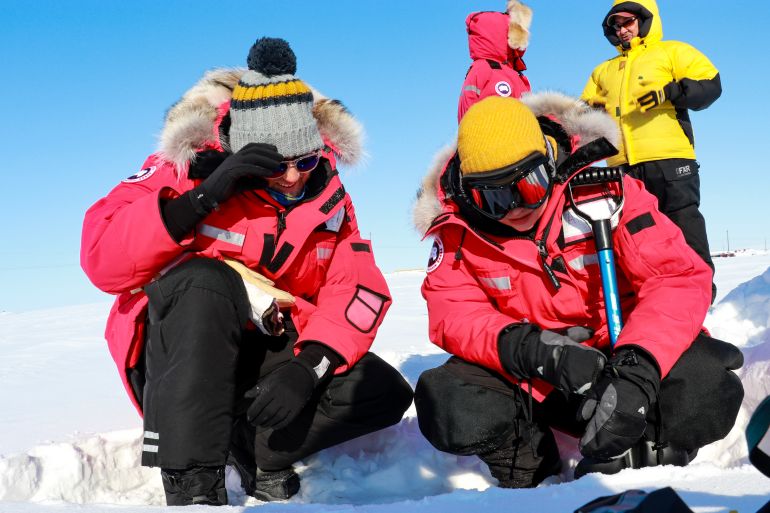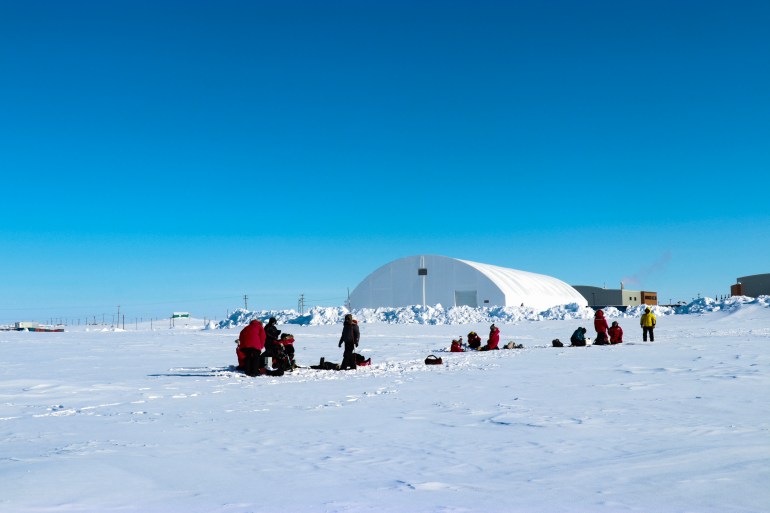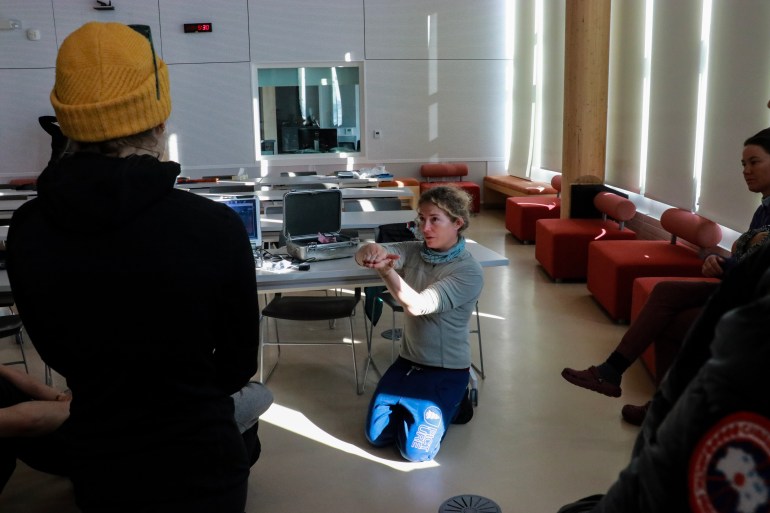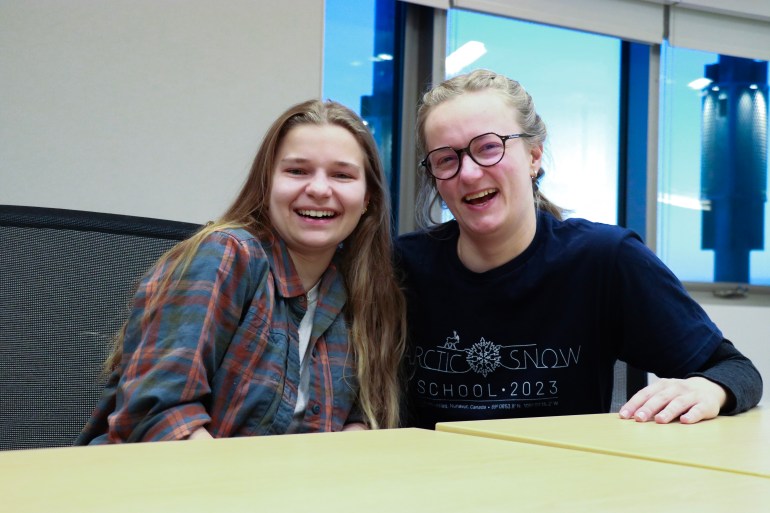Canadian Arctic Snow School hopes to boost climate fight
Researchers hope first-ever ‘Arctic Snow School’ in Nunavut will bolster cooperation, understanding of changing region.

Reporting for this story was made possible through the Pulitzer Center for Crisis Reporting’s Persephone Miel Fellowship.
Iqaluktuuttiaq, Nunavut, Canada – Marie Dumont’s face is flush. It is a windy Tuesday afternoon in the small hamlet of Iqaluktuuttiaq, in Canada’s northern territory of Nunavut, and the temperature outside is roughly -25 degrees Celsius (-13 degrees Fahrenheit).
Keep reading
list of 3 itemsUN agrees on role for Int’l Court of Justice in climate change
Climate change: Major glaciers worldwide to disappear by 2050
For much of the past week, Dumont has been working in these subzero temperatures alongside a dozen young scientists and students to better understand Arctic snow, and what it can say about how to address climate change-related challenges.
She is part of a group of 40 researchers, students and Inuit knowledge-holders participating in the first-ever Arctic Snow School, held in early April at the Canadian High Arctic Research Station (CHARS).
“I love it … some people know more about snow than me,” said Dumont, a research scientist and head of the Snow Research Center at the National Centre for Meteorological Research in Grenoble, France.
“The school is super diverse and everyone here comes from different countries, different backgrounds, and different science fields.”

Studying snow
The Arctic Snow School is a joint project between two institutions in the Canadian province of Quebec: Sentinel North at Universite Laval and the Groupe de Recherche Interdisciplinaire sur les Milieux Polaires (GRIMP) at the University of Sherbrooke.
The goal, organisers say, “is to help train a new generation of scientists capable of solving the complex problems of a changing North”.
Changes in this massive territory also have global implications; as Greenpeace explains, “the Arctic helps to regulate the world’s temperature, so as more Arctic ice melts the warmer our world becomes”. Understanding how the environment is changing, and how quickly, can help craft solutions, experts say.
Alexandre Langlois, co-lead of the initiative and a professor at the University of Sherbrooke, said studying Arctic snow can help researchers better assess how Arctic vegetation is changing, what access animals such as lemmings and caribou will have to food and safe habitats, and new challenges faced by Inuit who travel the region to hunt and fish.
One of the field campaigns at the school involved using a radiometer to better understand rain-on-snow events, which occur when rain falls onto existing snow and freezes, forming a layer of ice. The radiometer measures energy coming out of the snow, which indicates how much rain has fallen and how it is changing the different snow layers that are part of the larger snowpack.
Langlois said the Arctic is seeing more rain-on-snow events, but it is unclear what the root cause is due to a lack of on-the-ground data. He said that for caribou, this has meant difficulty foraging for lichen buried beneath the frozen ice. In the long run, these events could also cause damage to infrastructure that is not designed for frequent rains.
Measuring the likelihood and effect of rain-on-snow in Arctic conditions is an important first step in brainstorming solutions to the problem, Langlois told Al Jazeera.
“We’ve developed a method with the radiometers on the ground here to retrieve the presence of liquid water at the surface when it is raining, and with that data, what we can do afterwards is apply it to satellite imagery,” he said of the process.
“By doing that you’re then able to make maps about the occurrence of rain or snow events — to see if a year has had more rain on snow than usual, if there are any hotspots that we know have more of those events and what causes them.”
Studying Arctic snow specifically can also fill a gap in knowledge, said Florent Domine, one of the snow school organisers and a professor specialising in snow physics at Universite Laval, because it “has been little studied compared to alpine snow”.
According to Dumont, the French researcher who has spent more than a decade studying snow in the Alps, there are significant differences between Alpine and Arctic snow – starting with the diverse properties between the two.

In the Alps, researchers are often working in more than 1 metre (3.3 feet) of snow, and higher temperatures can lead to rain and melting, she told Al Jazeera. But in the Arctic, the snow is shallower and “evolving” due to more extreme and fluctuating temperatures — over the course of the week, Dumont and her team have conducted field research in temperatures ranging from -30C to -13C (-22F to 8.6F).
The Arctic conditions also affect the tools researchers can use; this week, Dumont said, a computer and a spectrometer – an instrument that measures “albedo”, or light reflected off a surface – stopped working after 30 minutes due to the cold. “This is new to me,” she said.
Intercultural exchange
Meanwhile, training young scientists to conduct field research on snow is also an opportunity to harness the power of local Inuit communities who have lived experience with changing snow conditions instead of relying solely on data collected through the use of technology.
“Hopefully, the legacy of this school will be to improve the way that collaboration is conducted and we move more towards co-managing research projects,” said Langlois, the school’s co-lead, “rather than just being Western scientists supported with traditional knowledge.”
Annelise Waling and Juliette Ortet, two snow school students, said going to Iqaluktuuttiaq was an opportunity to gain hands-on experience — digging snow pits, examining the surface area of snow grains, and understanding snow layers and the weather changes that cause them.
Waling, a master’s student at the University of New Hampshire in the United States, studies atmospheric rivers around Greenland’s ice sheet, while Ortet is a PhD student at universities in France and Canada focusing on changes to Arctic permafrost using remote sensing. Neither of them has focused on better understanding snow before.
Waling and Ortet also said they wanted to better understand climate change in relation to Indigenous communities. “Our exchanges with Inuit elders and with people from the community [are] super important to me,” Ortet said.

Three Inuit students from the environmental technology programme at Nunavut Arctic College, as well as five Indigenous hunters and knowledge-holders, are participating in the school, hoping to shed light on how climate change has affected their culture, traditions and way of life.
For Sharlyne Fay Umphrey, a student at the college, it has been heartening to see participants, both young and old, who are not Inuit and not from Nunavut, share the same interests and passions.
“It’s nice to see that you have people from all over the world that have the same interest in snow,” she said. “Just seeing snow in their perspective — that people think of it in many different ways and how it’s important.”